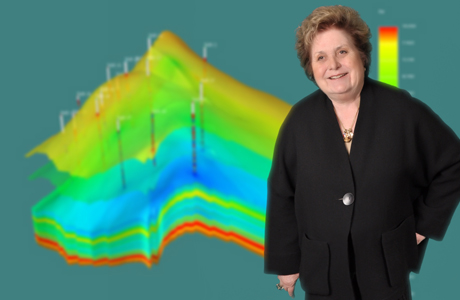Mary Wheeler solves the unsolvable to model the invisible, and in the process, she provides solid answers to improve groundwater quality or find oil and gas.
 Deep beneath the earth’s surface, complex fluid flow phenomena play out that can have significant implications for human surface dwellers. These phenomena impact such things as oil and gas recovery, the spread of groundwater contaminants and the viability of carbon sequestration schemes.
Deep beneath the earth’s surface, complex fluid flow phenomena play out that can have significant implications for human surface dwellers. These phenomena impact such things as oil and gas recovery, the spread of groundwater contaminants and the viability of carbon sequestration schemes.
To gain a better understanding of these processes, professor Mary Wheeler, who holds the Ernest and Virginia Cockrell Chair in Engineering, and her team of graduate students and post docs at the Center for Subsurface Modeling (CSM) in the Institute for Computational Engineering and Sciences, run simulations on some of the most powerful computers in the world such as the IBM Blue Gene system and the Texas Advanced Computing Center’s Ranger supercomputer.
Modeling real-world problems is a complex undertaking, and the scientists and engineers doing this work must overcome difficult technical challenges. Physical models need to be described by mathematical equations and algorithms, or sets of instructions must be formulated that can accurately approximate these equations. In addition, software based on these algorithms must be implemented efficiently.
Wheeler, as director of the CSM, focuses on developing and refining algorithms that apply massive parallel computational power to equations that describe subsurface processes.
“You have huge complicated systems of equations with billions of unknowns that describe events taking place over time, and these equations are dynamic,” Wheeler said. “One of the problems relates to scale – you have kilometers of area, yet many of the effects occur at the microscopic level. Then you have certain equations for near the surface, equations for deeper under the surface and special equations at the well sites. There is compaction and subsidence, and not just one fluid but many fluids with different phases – solid, liquid and gas. All of these are described by the equations and the algorithm has to keep track of them.”
Complicating matters further, most of the equations in these simulations are not readily solved. Instead, Wheeler uses mathematics to develop methods to find approximate solutions within known error bounds.
“There are many engineering problems where you can’t write down a simple closed-form solution, something like x + y = 5,” Wheeler said. “Instead, you have to numerically approximate the solutions, and that’s really where computational science comes in. Our CSM group has a reputation for demonstrating that these algorithms can be applied to real problems.”
One of Wheeler’s primary research areas involves partial differential equations, and using mixed finite element and finite volume methods to find approximate solutions to these equations. These are mathematical techniques that allow Wheeler to control the precision of the approximations in computer models to ensure that simulations provide the required accuracy for relevant data.
“My real work is to make sure that we are solving the problem we want to solve,” Wheeler said. “There is a model, some equations, which describe the problem. Given those equations, how do you solve those problems with a computer and how do you make sure you get something that makes sense.”
Wheeler, whose doctoral studies were in mathematics, is a professor in the Department of Mathematics at the university. But with her expertise in applying mathematics to solve engineering problems, she is also a professor in both the Aerospace Engineering and Engineering Mechanics and the Petroleum and Geosystems Engineering departments. For her accomplishments in engineering, Wheeler was elected to the National Academy of Engineering and she holds honorary doctorates from both the Colorado School of Mines and Technische Universiteit Eindhoven in the Netherlands.
Wheeler also serves as associate director of the Center for Frontiers of Subsurface Energy Security(CFSES), a collaboration between the university and Sandia National Laboratories. Funded by the U.S. Department of Energy, CFSES is exploring the physical, chemical and biological processes related to subsurface storage of carbon dioxide and related energy production byproducts. CFSES, like the CSM, is a multidisciplinary environment that brings together engineers and scientists from many different fields. It’s a setting that Wheeler enjoys.
“Today, you need people from many disciplines,” said Wheeler. “It’s exciting because no one person can be really cutting edge in any of these areas. The area where I am the most knowledgeable is math and numerical algorithms, but you need people from chemistry, physics and geology. I don’t want to do my work in isolation, where it’s not being driven by an application. That’s why I like engineering.”







